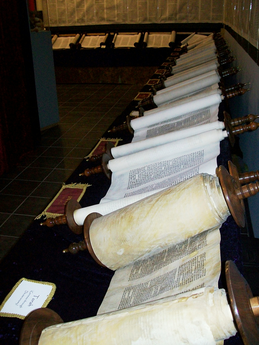
Back الكتاب العبري Arabic الكتاب العبرى ARZ Biblia hebrea AST Яўрэйская Біблія Byelorussian হিব্রু বাইবেল Bengali/Bangla کتێبی پیرۆزی عیبری CKB Hebrejská bible Czech Hebraiske Bibel Danish Hebrea Biblio Esperanto Biblia hebrea Spanish
| Hebrew Bible | |
|---|---|
| תַּנַ״ךְ, Tanakh | |
 Complete set of scrolls, constituting the Tanakh | |
| Information | |
| Religion | |
| Language | |
| Period | 8th/7th centuries BCE – 2nd/1st centuries BCE |
 | |||||
| Tanakh (Judaism) | |||||
|---|---|---|---|---|---|
|
|
|||||
| Old Testament (Christianity) | |||||
|
|
|||||
| Bible portal | |||||
The Hebrew Bible or Tanakh[a] (/tɑːˈnɑːx/;[1] Hebrew: תַּנַ״ךְ Tanaḵ), also known in Hebrew as Miqra (/miːˈkrɑː/; Hebrew: מִקְרָא Mīqrāʾ), is the canonical collection of Hebrew scriptures, comprising the Torah, the Nevi'im, and the Ketuvim. Different branches of Judaism and Samaritanism have maintained different versions of the canon, including the 3rd-century BCE Septuagint text used in Second Temple Judaism, the Syriac Peshitta, the Samaritan Pentateuch, the Dead Sea Scrolls, and most recently the 10th-century medieval Masoretic Text compiled by the Masoretes, currently used in Rabbinic Judaism.[2] The terms "Hebrew Bible" or "Hebrew Canon" are frequently confused with the Masoretic Text; however, this is a medieval version and one of several texts considered authoritative by different types of Judaism throughout history.[2] The current edition of the Masoretic Text is mostly in Biblical Hebrew, with a few passages in Biblical Aramaic (in the books of Daniel and Ezra, and the verse Jeremiah 10:11).[3]
The authoritative form of the modern Hebrew Bible used in Rabbinic Judaism is the Masoretic Text (7th to 10th century CE), which consists of 24 books, divided into chapters and pesuqim (verses). The Hebrew Bible developed during the Second Temple Period, as the Jews decided which religious texts were of divine origin; the Masoretic Text, compiled by the Jewish scribes and scholars of the Early Middle Ages, comprises the Hebrew and Aramaic 24 books that they considered authoritative.[2] The Hellenized Greek-speaking Jews of Alexandria produced a Greek translation of the Hebrew Bible called "the Septuagint", that included books later identified as the Apocrypha, while the Samaritans produced their own edition of the Torah, the Samaritan Pentateuch. According to the Dutch–Israeli biblical scholar and linguist Emanuel Tov, professor of Bible Studies at the Hebrew University of Jerusalem, both of these ancient editions of the Hebrew Bible differ significantly from the medieval Masoretic Text.[2]
In addition to the Masoretic Text, modern biblical scholars seeking to understand the history of the Hebrew Bible use a range of sources.[4] These include the Septuagint, the Syriac language Peshitta translation, the Samaritan Pentateuch, the Dead Sea Scrolls collection, the Targum Onkelos, and quotations from rabbinic manuscripts. These sources may be older than the Masoretic Text in some cases and often differ from it.[5] These differences have given rise to the theory that yet another text, an Urtext of the Hebrew Bible, once existed and is the source of the versions extant today.[6] However, such an Urtext has never been found, and which of the three commonly known versions (Septuagint, Masoretic Text, Samaritan Pentateuch) is closest to the Urtext is debated.[7]
There are many similarities between the Hebrew Bible and the Christian Old Testament. The Protestant Old Testament has the same books as the Hebrew Bible, but the books are arranged in different orders. The Catholic, Eastern Orthodox, Oriental Orthodox, and Assyrian churches include the Deuterocanonical books, which are not included in certain versions of the Hebrew Bible.[8] In Islam, the Tawrat (Arabic: توراة) is identified not only with the Pentateuch (the five books of Moses), but also with the other books of the Hebrew Bible.[9]
Cite error: There are <ref group=lower-alpha> tags or {{efn}} templates on this page, but the references will not show without a {{reflist|group=lower-alpha}} template or {{notelist}} template (see the help page).
- ^ "Tanach" Archived 2016-03-04 at the Wayback Machine. Random House Webster's Unabridged Dictionary.
- ^ a b c d Tov, Emanuel (2014). "The Myth of the Stabilization of the Text of Hebrew Scripture". In Martín-Contreras, Elvira; Miralles Maciá, Lorena (eds.). The Text of the Hebrew Bible: From the Rabbis to the Masoretes. Journal of Ancient Judaism: Supplements. Vol. 103. Göttingen: Vandenhoeck & Ruprecht. pp. 37–46. doi:10.13109/9783666550645.37. ISBN 978-3-525-55064-9. Archived from the original on 2023-02-15. Retrieved 2023-02-16.
- ^ Jeremiah 10:11
- ^ "Scholars seek Hebrew Bible's original text – but was there one?". Jewish Telegraphic Agency. 2014-05-13. Archived from the original on 2016-11-05. Retrieved 25 September 2015.
- ^ Weiss, Anthony (14 May 2014). "Controversy lurks as scholars try to work out Bible's original text". The Times of Israel. Archived from the original on 25 September 2015. Retrieved 25 September 2015.
- ^ Isaac Leo Seeligmann, Robert Hanhart, Hermann Spieckermann: The Septuagint Version of Isaiah and Cognate Studies, Tübingen 2004, pp. 33–34.
- ^ Shanks, Herschel (1992). Understanding the Dead Sea Scrolls (1st ed.). Random House. p. 336. ISBN 978-0679414483.
- ^ Andersen, Alex (Spring 2019). "Reconsidering the Roman Catholic Apocrypha". Classical Conversations. 3. Lakeland, Florida: Southeastern University: 1–47. Archived from the original on 16 February 2023. Retrieved 15 February 2023.
- ^ Isabel Lang Intertextualität als hermeneutischer Zugang zur Auslegung des Korans: Eine Betrachtung am Beispiel der Verwendung von Israiliyyat in der Rezeption der Davidserzählung in Sure 38: 21-25 Logos Verlag Berlin GmbH, 31.12.2015 ISBN 9783832541514 p. 98 (German)